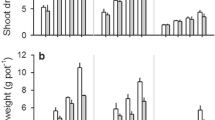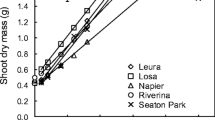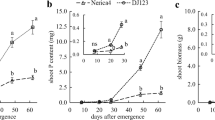Abstract
Phosphorus deficiency is a major yield limiting constraint in wheat cultivation on acid soils. The plant factors that influence P uptake efficiency (PUPE) are mainly associated with root characteristics. This study was conducted to analyze the genotypic differences and relationships between PUPE, root length density (RLD), colonization by vesicular arbuscular and arbuscular mycorrhizal (V)AM fungi and root excretion of phosphatases in a P-deficient Andisol in the Central Mexican Highlands. Forty-two semidwarf spring-bread-wheat (Triticum aestivumL.) genotypes from CIMMYT were grown without (−P) and with P fertilization (+P), and subsequently in subsets of 30 and 22 genotypes in replicated field trials over 2 and 3 years, respectively. Acid phosphatase activity at the root surface (APASE) was analyzed in accompanying greenhouse experiments in nutrient solution. In this environment, PUPE contributed more than P utilization efficiency, in one experiment almost completely, to the variation of grain yield among genotypes. Late-flowering genotypes were higher yielding, because the postanthesis period of wheat was extended due to the cold weather at the end of the crop cycles, and postanthesis P uptake accounted for 40–45% of total P uptake. PUPE was positively correlated with the numbers of days to anthesis (at −P r=0.57 and at +P r=0.73). The RLD in the upper soil layer (0–20 cm) of the wheat germplasm tested ranged from 0.5 to 2.4 cm cm-3 at –P and 0.7 to 7.7 at +P. RLD was the most important root trait for improved P absorption, and it was positively genetically correlated with PUPE (at –P r=0.42 and at +P r=0.63) and the number of spikes m-2 (at –P r=0.58 and at +P r=0.36). RLD in the upper soil layer was more important with P fertilizer application. Without P fertilization, root proliferation in the deeper soil profile secured access to residual, native P in the deeper soil layer. (V)AM-colonisation and APASE were to a lesser degree correlated with PUPE. Among genoptypes, the level of (V)AM-colonisation ranged from 14 to 32% of the RLD in the upper soil layer, and APASE from 0.5 to 1.1 nmol s-1 plant-1 10-2.
Similar content being viewed by others
References
Adams F 1974 Soil solution. In The Plant Root and its Environment. Ed EW Carson. pp 441–482. University Press of Virginia, Charlottesville.
Atkinson D 1990 Influence of root system morphology and development on the need for fertilizers and the efficiency of use. In Crops as Enhancers of Nutrient Use. Eds V C Baligar and R R Duncan. pp 411–451. Academic Press, San Diego, California.
Baligar V C and Duncan R R 1990 Crops as enhancers of nutrient use. Academic Press, San Diego, California.
Barber S A, Walker J M and Vasey E H 1962 Principles of ion movement through the soil to the plant root. Trans. Int. Soil Sci. Soc. Comm. 4-5, 121–124.
Barraclough P B 1986 The growth and activity of winter wheat roots in the field: nutrient inflows of high yielding crops. J. agric. Sci. Camb. 106, 53–59.
Batten G D 1992 A review of phosphorus efficiency in wheat. Plant Soil 146, 163–168.
Batten G D, Khan MA and Cullis B R 1984 Yield response by modern wheat genotypes to phosphate fertilizer and their implications for breeding. Euphytica 33, 81–89.
Bieleski R L 1976 Phosphate pools, phosphate transport and phosphate availability. Annu. Rev. Plant Physiol. 24, 225–252.
Blair G 1993 Nutrient efficiency - what do we really mean. In Genetic Aspects of Plant Mineral Nutrition. Eds P J Randall, E Delhaize, R A Richards and R Munns. pp 205–213. Kluwer Academic Publishers, The Netherlands.
Blum A 1996 Yield potential and drought resistance: are they mutually exclusive? In Increasing Yield Potential in Wheat: Breaking the Barriers. Eds MPS Reynolds, S Rajaram and A McNab. pp 90–100. Mexico, D.F.: CIMMYT.
Böhm W1979 Methods of Studying Root Systems. Springer Verlag, New York.
Bolan N S 1991 A critical review on the role of mycorrhizal fungi in the uptake of phosphorus by plants. Plant Soil 134, 189–207.
Bumb B L and Baanante C A 1996 The role of fertilizers in sustaining food security and protecting the environment: trends to 2020.Washington, D.C: International Food Policy Research Institute. Food, Agriculture and the Environment Discussion Paper 17.
Byerlee D 1994 Modern varieties, productivity and sustainability: recent experience and emerging challenges. CIMMYT Mexico, D.F.
Dalal R C 1978 Organic phosphorus. Adv. Agron. 29, 83–117.
Duff R B, Wembley D M and Scott R O 1963 Solubilization of minerals and related materials by 2-ketogluconic acid producing bacteria. Soil Sci. 95, 105–114.
Falconer D S 1981 Introduction to quantitative genetics. Longman, London, New York.
FAO 1992 Fertilizer use by crop. Food and Agriculture Organization, International Fertilizer Industry Association and International Fertilizer Development Center.
Faquin V, Malavolta E and Muraoka T 1990 Cinética da absorςao de fosfato em soja sob influência de micorriza vesícolo-arbuscular. R. Bras. Ci. Solo 14, 41–48.
Gahoonia T S and Nielsen N E 1996 Variation in acquisition of soil phosphorus among wheat and barley genotypes. Plant Soil 178, 223–230.
Gerloff S 1977 Plant efficiencies in the use of N, P and K. In Plant Adaptation to Mineral Stress in Problem Soils. Ed. M J Wright. pp 161–174. Cornell Univ. Press, New York.
Giovannetti M and Mosse B 1980 An evaluation of techniques for measuring vesicular-abuscular mycorrhizal infection in roots. New Phytol. 84, 489–500.
Haymann D S and Mosse B 1972 Plant growth response to vesicular-arbuscular mycorrhiza. III. Increased uptake of labile P from soil. New Phytol. 71, 41–47.
Hetrick B A D, Wlson G W T and Cox T S 1992 Mycorrhizal dependence of modern wheat varieties, landraces and ancestors. Can. J. Bot. 70, 2032–2040.
Hockett E A 1986 Relationship of adventitious roots and agronomic characteristics in barley. Can. J. Plant Sci. 66, 257–266.
Holford I C R 1997 Soil phosphorus - its measurement and its uptake by plants. Aust. J. Soil Res. 35 (2), 227–239.
Horst W J, Abdou M and Wiesler F 1993 Genotypic differences in phosphorus efficiency of wheat. Plant Soil 155, 293–296.
Jones G P D, Jessop R S and Blair G J 1992 Alternative methods for the selection of phosphorus efficiency in wheat. Field Crops Res. 30, 29–40.
Kemp P D and Blair G J 1994 Phosphorus efficiency in pasture species, VIII Ontogeny, growth, P acquisition and P utilization of Italian ryegrass and Phalaris under P deficient and P sufficient conditions. Aust. J. Agric. Res. 45, 669–688.
Kitson R E and M G Mellon 1944 Colometric determination of phosphorus as molybdovanado phosphoric acid. Industr. Engineering Chem. Mal. Ed. 16, 379–383.
Manske G G B 1990 Genetical analysis of the efficiency of VA mycorrhiza with Spring Wheat: I. Genotypical differences and reciprocal cross between an efficient and non-efficient variety. In Genetic Aspects of Plant Mineral Nutrition. Eds N El Bassam, M Dambroth and B C Loughman. pp 397–405. Kluwer, Dordrecht, The Netherlands.
Manske G G B, Lüttger A B, Behl R K and Vlek P L G 1995 Nutrient efficiency based on VA mycorrhizae (VAM) and total root length of wheat cultivars grown in India. Angew. Bot. 69, 108–110.
Matar A, Torrent J and Ryan J 1992 Soil and fertilizer phosphorus and crop response in the dryland Mediterranean zone. Advances in Soil Science 18, 81–146.
McLachlan K D 1980 Acid phosphatase activity of intact roots and phosphorus nutrition of plants. II. Variation among wheat roots. Aust. J. Agric. Res. 31, 441–448.
Mengel K 1982 Factors of plant nutrient availability relevant to soil testing. Plant Soil 64, 129–138.
Moll R H, Kamprath E J and Jackson W A 1982 Analysis and interpretation of factors which contribute to efficiency of nitrogen utilization. Agronomy J. 74, 562–564.
Monyo J H and Whittington W J 1970 Genetic analysis of root growth in wheat. Agric. Sci. Camb. 74, 329–338.
Olsen S R, Cole C V, Watanabe F S and Dean L A 1954 Estimation of available phosphorus in soils by extraction with sodium bicarbonate. U.S. Dep. Agric. Circ. 939.
Römer W and Schilling G 1986 Phosphorus requirements of the wheat plant in various stages of its life cycle. Plant Soil 91, 221–229.
Römer W, Augustin J and Schilling G 1988 The relationship between phosphate adsorption and root length in nine wheat cultivars. Plant Soil 111, 199–201.
Rosa O S and Carmago C E O 1990 Wheat breeding for better efficiency in phosphorus. In Wheat for the Nontraditional Warm Areas Mexico. Ed. D A Saunders. pp 333–351. CIMMYT, Mexico D.F.
Rovira A D 1969 Plant root exudates. Bot. Rev. 35, 35–57.
Sadhu D and Bhaduri P N 1984 Variable traits of roots and shoots of wheat. Z. Acker-Pflanzenbau 110, 299–331.
Sanchez P A and Uehara G 1980 Management consideration for acid soils with high phosphorus fixation capacity. In The Role of Phosphorus in Agriculture. Eds F E Khaswana, E C Sample and E J Kamprath. pp 471–514. Am. Soc. Agron., Madison, Wisconsin.
SAS Institute 1985 SAS User Guide: Statistics. Version 5 ed. SAS Inst., Cary. NC.
Sato A, Oyanagi A and Wada M 1993 Relation between shoot phosphorus content and tillering rate in wheat varieties varied in adaptability to low available phosphoric-acid soil. Jpn. J. Crop Sci. 62, 257–260.
Sattelmacher B, Horst W J and Becker H C 1994 Factors that contribute to genetic variation for nutrient efficiency of crop plants. Z. Pflanzenernähr. Bodenk. 157, 215–224.
Seeling B and Jungk A 1996 Utilization of organic phosphorus in calcium chloride extracts of soil by barley plants and hydrolysis by acid and alkaline phosphatase. Plant Soil 178, 179–184.
Sieverding E 1991 Vesicular-arbuscular mycorrhiza management in tropical agrosystems. GTZ bulletin 224, Eschborn, Germany.
Smucker A J M, McBurney S L and Srivastava A K 1982 Quantitative separation of roots from compacted soil profiles by the hydro-pneumatic eludration system. Agron. J. 74, 500–503.
Tabatabai M A and Bremner J M 1969 Use of p-nitrophenylphosphate for assay of soil phosphatase activity. Soil Biol. Biochem. 1, 301–307.
Tennant D 1975 A test of modified line intersect method of estimating root length. L. of Ecology 63, 995–1001.
Vlek P L G, Kühne R F and Denich M 1997 Nutrient resources for crop production in the tropics. Phil. Trans. R. Soc. Lond. B 352, 975–985.
Vlek P L G, Lüttger A B and Manske G G B 1996 The potential contribution of arbuscular mycorrhiza to the development of nutrient and water efficient wheat. In The Ninth Regional Wheat Workshop for Eastern, Central and Southern Africa. Eds D G Tanner, T S Payne and O S Abdalla. pp 28–46. CIMMYT, Addis Ababa, Ethiopia.
Wheeler D M, Edmedeas D C, Christie R A and Gardner R 1992 Effect of aluminum on the growth of 34 plant species: a summary of results obtained in low ionic strength solution culture. Plant Soil 146, 61–66.
Zadoc J C, Chang T T and Konzak C F 1974 A decimal code for the growth stages of cereals. Weed Research 14, 415–421.
Rights and permissions
About this article
Cite this article
Manske, G., Ortiz-Monasterio, J., Van Ginkel, M. et al. Traits associated with improved P-uptake efficiency in CIMMYT's semidwarf spring bread wheat grown on an acid Andisol in Mexico. Plant and Soil 221, 189–204 (2000). https://doi.org/10.1023/A:1004727201568
Issue Date:
DOI: https://doi.org/10.1023/A:1004727201568




